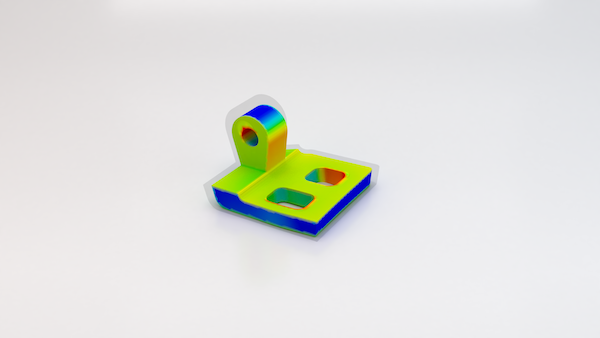Editor’s Pick: Limiting the complexity of metal binder jetting printing
Hexagon Manufacturing Intelligence Simufact Additive Module for Metal Binder Jetting uses company's simulation technology to shorten the steep learning curve related to use of MBJ.

Hexagon Manufacturing Intelligence has a new module for Simufact Additive that eliminates the complexity of working with Metal Binder Jetting, reducing the complexity of building metal parts by accounting for shrinkage and distortion during simulation. Image courtesy of Hexagon Manufacturing Intelligence.
Latest News
October 14, 2020
Hexagon Manufacturing Intelligence makes available a new Simufact Additive module to prevent the distortions and other issues common to the metal binder jetting (MBJ) additive manufacturing (AM) process. This new module uses Hexagon’s simulation technology to shorten the steep learning curve associated with the use of MBJ.
Hexagon says MBJ is gaining popularity due to its ability to print high volumes of parts with minimal spacing. It offers the possibility of larger lot sizes, and does not require support structures to be applied to parts during the printing process. These advantages make it a natural for replacing low-volume, high-cost metal injection molding processes for a variety of industries including aerospace, automotive and medical. MBJ is also being used as a way to reduce costs and lead times associated with the production of complex and lightweight metallic parts like gears and turbine wheels, thanks to its ability to achieve high resolution.
Hexagon says all these advantages come with a downside, starting with a steep learning curve. For users to fully exploit its advantages, users need to be able to accurately predict changes during the sintering process. Parts are susceptible to as much as 35% shrinkage, yet CAD/CAE models that work with other AM processes aren’t able to accurately predict MBJ distortions. As a result, manufacturers have to rely on physical trials to perfect AM print jobs. This need for extra time and steps has discouraged many from reaping the potential benefits.
“During the sintering process, the part undergoes a non-uniform, anisotropic shrinkage that is largely unpredictable just by an engineer’s experience,” notes Jeff Robertson, in charge of business development for Simufact. “The shrinkage compensation scale factors used in the past are just not up to the task of predicting the final part shape or the required pre-compensated geometry.”

Robertson says the process can be subject to the effects of gravity, with a part slumping under its own weight and from the friction of the interface between the part and any supports or baseplate. “As a consequence, the ability to successfully complete the sintering process and obtain a part that is within the acceptable dimensional tolerance can be extremely difficult,” Robertson adds.
The new Metal Binder Jet sintering modules within Simufact Additive are written specifically to take on these challenges. The software uses a visco-plastic multiphysics approach to predict shrinkage due to sintering and deformation along with other outputs such as grain size, local relative density, stress and strain. Hexagon says design engineers are also able to predict and mitigate risk of part failure due to cracking or separation. The result, Hexagon says, is the ability to model a part that considers the realities of the MBJ process and is producible while also helping engineers evaluate and mitigate risk during the manufacturing process.
“Shrinkage and distortion can be predicted and compensated automatically according to the local behavior of the part,” says Dr. Patrick Mehmert, solutions manager, Additive Manufacturing for Simufact. “This makes costly and time-consuming trial-and-error iterations unnecessary to find an adapted part design that leads to a final part within the desired tolerances.”
Like other Simufact modules, the tool is aimed at production engineers, not just simulation specialists. In that vein, the MBJ module automates model setup, and preparation of CAD or CAE files can also be automated through Python scripts.
The upgrade for this new MBJ technology is now available to Simufact Additive users.
Sources: Press materials received from the company and additional information gleaned from the company’s website.
More Hexagon Manufacturing Intelligence Coverage
Subscribe to our FREE magazine, FREE email newsletters or both!
Latest News
About the Author
DE’s editors contribute news and new product announcements to Digital Engineering.
Press releases may be sent to them via DE-Editors@digitaleng.news.






